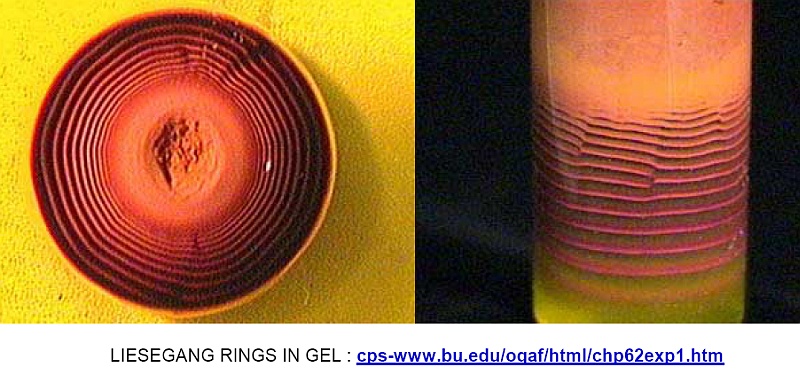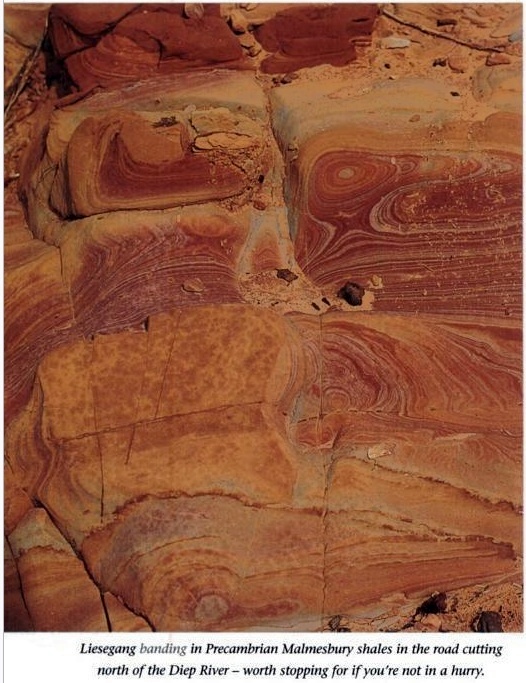It was the year 1896. The German chemist, Raphael E. Liesegang,
was busy in his lab when he accidentally dropped a drop of silver
nitrate solution on a layer of gel containing potassium dichromate.
This caused concentric rings of silver dichromate to form (like in
the picture below, left). When formed in a test tube by diffusing
one component from the top, layers or bands (rather than rings) of
precipitate form (see below, right).

Liesegang banding/rings can sometimes be seen in weathered rock
as very eye-catching colour banding. Examples can be fan-shaped,
others closely resemble sedimentary cross-bedding (but their
orientation can be seen to cut primary, sedimentary features).
Although easily mistaken for bedding, a close look will usually
show that the banding is in fact something quite different.

This picture from Geological Journeys by Norman
& Whitfield was taken near the cache location. However, I could
not find this particular example when placing the cache. Judging by
the differences in the pictures from the logs, it seems like the
phenomena is constantly changing as the (relatively soft) rock
erodes.
Liesegang banding forms deep underground by the rhythmic
deposition of various iron and manganese compounds from
mineral-rich groundwater that once flowed within the permeable rock
and along bedding and joint planes. Over long periods of time, the
water leaches soluble material - mainly iron - from the rock and
carries it along in solution. Sooner or later the water evaporates
or the chemical environment changes, the material is no longer
stable in solution, and it precipitates. Water moves along a
'front', as though in a wave. If anything were equal, these fronts
would be straight. However, there are subtle but important
differences in permeability, so the front becomes distorted and
sinuous. This results in either colour banding, sometimes in very
beautiful brightly hued patterns, or hardening alongside
joint-planes, giving rise to a pitted, box-work appearance.
In sedimentary rocks, Liesegang bands thus appear well after the
sediment has become rock. Stratification and lamination within the
sandstone, or Malmesbury shale in this case, are typically
cross-cut by the Liesegang bands which entirely 'ignore' the
original lamination; fractures usually have a more obvious effect
on the distribution and orientation of these. Liesegang banding is
even seen in granite, a non-sedimentary rock.
In humans Liesegang rings occur in inflammatory breast
lesions.
Sources:
To claim "Found it" you must email me satisfactory responses to
the following:
Any logs not accompanied by an email will be deleted.
- Find the best example of Liesegang banding that you can spot in
the area around the designated coordinates and send me a close-up
picture of it with your navigation device for scale.
- If you were to keep licking a multi-layered candy ball on its
one side only,
concentric rings will be revealed. Is this the same mechanism
as with Liesegang rings? Explain your answer.
- What substance do you think is responsible for the red colour
in these bands?
- Optional: Send me a picture of you/your party taken with
this feature in the background.
Note: Do not post any spoiler
pictures/hints to this page, even if encrypted.